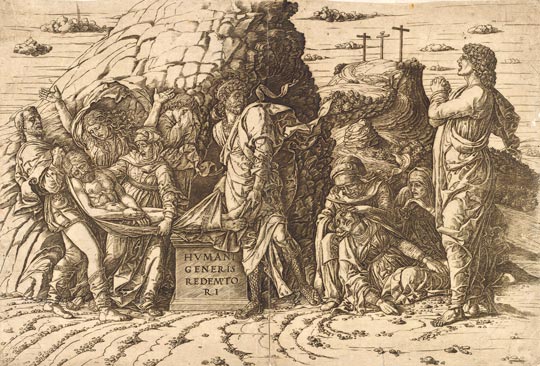Mantegna "invenit"
Mantegna and engraving
In 1550, in his "Life" of the artist, Giorgio Vasari described Mantegna as the inventor of copperplate engraving in Italy, thus creating a real myth. Specialists are still divided over this question: some consider that Mantegna never handled a burin himself but provided designs for printmaking. As court painter, Mantegna was under the strict control of the Gonzaga family who forbade him to sell his works. This new reproduction technique, in addition to its particular expressive qualities, enabled him to export his inventions outside Mantua. The contract signed in 1475 with Gian Marco Cavalli is explicit: the young goldsmith was obliged to keep his models and prints secret, under threat of severe penalties. For having done just this, Simone Ardizzoni, another engraver, was severely beaten on Mantegna's orders, and was to claim justice from the Marquis.
The inventory of the possessions of Ludovico, Mantegna's son, who died in 1510, mentions several copper plates on which were engraved different compositions displayed in this room.
The diffusion of "Mantegnesque" models
Archival documents testify Mantegna's close links with the world of Applied Arts and explain the rapid and extensive diffusion of his inventions. His collaboration with craftsmen seems to have been fruitful: he thus provided models for metal lamps, tapestries or receptacles… Not a single one, unfortunately, has survived.
Among decorative art drawings of this period that have come down to us, attempts have been made to find echoes of a "Mantegna style" or of the artist's ideas. The sheet with a bird from Washington, for example, could be linked to a sumptuous pole, carved and painted with animals by Mantegna, of the tent presented in 1494 by the Duke of Ferrara, Ercole I d'Este to Charles VIII, King of France, on the occasion of his arrival in Italy.
Some artists did not hesitate to exploit his inventions, unknown to Mantegna, in unique pieces or in series; thus two Lombard sculptors, the De Donati brothers, interpreted in a sentimental manner the Entombment, and the illuminator of Pliny the Elder's Historia Naturalis borrows from the famous engraving on the theme of the Battle of Sea Gods the motif of two duelling tritons armed with fish.
Andrea Mantegna (Isola di Carturo, circa 1431 - Mantua, 1506)
Entombment (horizontal)
circa 1470-1475
Burin and dry point; H. 29.9 cm; W. 44.2 cm
Washington, National Gallery of art, 1986-98-1
© Courtesy of the Board of Trustees, National Gallery of Art, Washington







